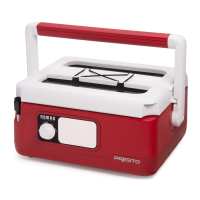4
Care and Cleaning
1. Remove plug from wall outlet and allow slow cooker to cool completely before cleaning.
2. Wash the removable cooking pot in warm water and a mild detergent. Rinse and dry thoroughly.
The cooking pot may be washed in the dishwasher; however, when cleaning in the dishwasher, do not use rinse aids or hard water
deposit removers, such as Lemi Shine* rinse or Lemi Shine* booster.
IMPORTANT: To prevent damage to the slow cooker parts, do not use steel wool scouring pads, abrasive cleaners, bleach, vinegar,
lemon juice, or other acid-based cleaners.
NOTICE: Always make sure the cooking pot is completely dry before placing it back into the slow cooker base. Placing a wet cooking
pot into the slow cooker base may damage the unit and cause it to malfunction.
3. Remove the utensil holder from the cover and detach the silicone cord. Wash the cord and holder in warm, soapy water.
4. Remove the cover by lifting it to an upright position and then straight up off the cooker base. Do not immerse the cover in water or
wash it in a dishwasher. Clean the cover, including the gasket, with a damp, soapy cloth. Be sure to also clean under the grommet in
the glass window. If necessary, clean the center of the grommet with a Q-tip** cotton swab.
If you accidentally immerse the cover, you will need to dry the cover in a vertical position with the hinges resting on the counter. This
will allow water to drain out. Once the cover is thoroughly dry, reattach it to the cooker base. Reattach the utensil holder.
5. Wipe the slow cooker base with a soft, damp cloth to clean.
CAUTION! To avoid electrical shock, never immerse the slow cooker base in water or other liquid or wash it in a dishwasher.
6. Pull the condensation collector out from the back of the slow cooker base (Fig. D, page 3). It collects condensation from the slow
cooker cover when the cover is opened. Empty any moisture that has collected. Wash the collector and reinsert it into the slow cooker
base.
7. Push the cord into the port on the back of the unit for convenient storage. Secure the end of the cord in the clip (Fig. D, page 3).
8. To prevent unpleasant odors from lingering, store the slow cooker with the carrying handle in the unlocked position and the cover
detached. Place the cover on the slow cooker base so the hinges rest on the hinge slots (Fig. A, page 2). Another option is to place a
folded dish cloth between the cover and base so the cover is slightly open.
Cover Care and Use Instructions
CAUTION! The glass in your cover may break for no apparent reason if you fail to follow these instructions. Broken glass can cause
personal injury or property damage. Do not use cover if the glass is chipped or cracked. Handle cover carefully and avoid rough handling.
Do not handle hot cover with a wet towel or place hot cover on a cold or wet surface. Sudden extreme changes in temperature may cause
glass to break. Allow cover to cool before cleaning. Do not scrape or gouge glass with hard or sharp utensils or clean with steel wool or
abrasive powders which can scratch or weaken the glass.
Tips for Successful Slow Cooking
• Browning meat and sautéing aromatic ingredients, such as onions and garlic, in a skillet prior to slow cooking is worth the extra
time. The flavor and appearance of the finished dish will be enhanced by this step. Additionally, browning will allow excess fat to be
drained from the meat before placing it in the slow cooker.
Browning is also important, from a food safety standpoint, when slow cooking large pieces of meat. Browning will increase the
temperature of the meat and destroy surface bacteria that are most likely to be present on large cuts of meat.
• Avoid opening the cover during cooking. This will cause the temperature inside the slow cooker to drop as much as 15 degrees,
resulting in longer cooking time. To view food without opening the cover, lightly tap the cover window to remove any condensation
that may have formed.
• A slow cooker prevents the loss of the moisture that develops as the food cooks. Therefore, when converting a favorite recipe for slow
cooking, reduce the liquid by 25 to 50 percent.
• Thaw frozen food before placing in the slow cooker.
• Vegetables such as carrots, celery, turnips, and potatoes cook slower than meat; therefore, put them on the bottom of the cooking pot.
• For uniform cooking, cut dense vegetables, such as carrots, potatoes, and turnips into similar-size pieces. Dense vegetables should
be cut into smaller pieces than more tender vegetables.
• Milk and other dairy products, seafood and fish, fresh herbs, and delicate vegetables do not hold up well under heat for long periods
of time. These ingredients should be added 30 minutes to 1 hour before the end of cooking.
*Lemi Shine is a registered trademark of Envirocon Technologies, Inc. **Q-tip is a registered trademark of Conopco, Inc. Presto is not affiliated with these companies.

